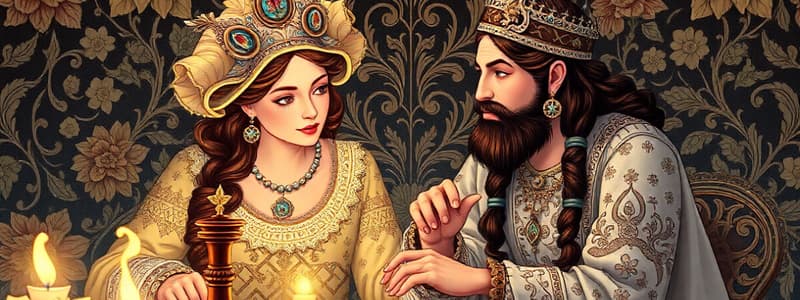Podcast
Questions and Answers
What role does the antagonist play in relation to the protagonist?
What role does the antagonist play in relation to the protagonist?
- The antagonist is the opposite of the protagonist. (correct)
- The antagonist must directly oppose every action of the protagonist.
- The antagonist is a supporting character for the protagonist.
- The antagonist is always portrayed as evil.
What is the purpose of the shadow character in a story?
What is the purpose of the shadow character in a story?
- To represent the hero’s opposite and often ultimate evil. (correct)
- To provide comic relief and lighten the story.
- To act as an advisor to the hero.
- To effectively steal the protagonist's role.
What is true about the mentor character in a narrative?
What is true about the mentor character in a narrative?
- The mentor typically hinders the hero's progress.
- The mentor may be younger than the protagonist.
- The mentor guides the hero with personal wisdom from experiences. (correct)
- The mentor always has a hidden agenda.
In what scenario do the protagonist and antagonist become linked together in a story?
In what scenario do the protagonist and antagonist become linked together in a story?
What character might represent the dark side of the hero?
What character might represent the dark side of the hero?
Which type of antagonist is characterized by a potential to be a protagonist?
Which type of antagonist is characterized by a potential to be a protagonist?
What role does an ally typically serve in a hero's journey?
What role does an ally typically serve in a hero's journey?
What is a common misconception regarding antagonists?
What is a common misconception regarding antagonists?
What motivates players identified as perceiving (P) in games?
What motivates players identified as perceiving (P) in games?
Which generation is associated with initiating a values-oriented spiritual revolution during the 1960s and 1970s?
Which generation is associated with initiating a values-oriented spiritual revolution during the 1960s and 1970s?
Which aspect of game design would best resonate with the values of the Boom Generation?
Which aspect of game design would best resonate with the values of the Boom Generation?
What is a common characteristic of players seeking mastery in games?
What is a common characteristic of players seeking mastery in games?
How did the Boom Generation's upbringing influence their worldview?
How did the Boom Generation's upbringing influence their worldview?
In the context of game-playing, how would the perception of high scores differ for a player motivated by mastery?
In the context of game-playing, how would the perception of high scores differ for a player motivated by mastery?
Which phrase best describes the gaming behavior of those focused on spontaneous engagement?
Which phrase best describes the gaming behavior of those focused on spontaneous engagement?
What societal change is most closely linked to the coming-of-age experience of the Boom Generation?
What societal change is most closely linked to the coming-of-age experience of the Boom Generation?
What is the primary focus of Act I in a traditional three-act plot structure?
What is the primary focus of Act I in a traditional three-act plot structure?
In the context of a game, what purpose does backstory serve?
In the context of a game, what purpose does backstory serve?
What is typically featured in the middle of a three-act plot structure?
What is typically featured in the middle of a three-act plot structure?
Which of the following best defines the theme of a story?
Which of the following best defines the theme of a story?
Why is establishing the synopsis or storyline important within a game?
Why is establishing the synopsis or storyline important within a game?
What is a common method of delivering backstory to the player?
What is a common method of delivering backstory to the player?
What role do obstacles in Act II play in the story structure?
What role do obstacles in Act II play in the story structure?
What should an effective summary of a game emphasize?
What should an effective summary of a game emphasize?
What role do supporting characters play in a story?
What role do supporting characters play in a story?
How does the relationship at the interpersonal level differ from other levels?
How does the relationship at the interpersonal level differ from other levels?
What is the goal of a protagonist at the team level?
What is the goal of a protagonist at the team level?
What character is referred to as an avatar?
What character is referred to as an avatar?
What does the community level represent in character dynamics?
What does the community level represent in character dynamics?
At what level does a protagonist experience self-actualization according to Maslow?
At what level does a protagonist experience self-actualization according to Maslow?
What is the primary function of non-player characters (NPCs) in games?
What is the primary function of non-player characters (NPCs) in games?
Which of the following is true regarding player characters?
Which of the following is true regarding player characters?
What specific historical event significantly influenced the Silent Generation's upbringing?
What specific historical event significantly influenced the Silent Generation's upbringing?
What characteristics are associated with the Silent Generation's mindset during their young adulthood?
What characteristics are associated with the Silent Generation's mindset during their young adulthood?
How do Millennials differ from Xers in terms of economic experience during their formative years?
How do Millennials differ from Xers in terms of economic experience during their formative years?
What type of game would likely resonate with players from the Millennial generation?
What type of game would likely resonate with players from the Millennial generation?
Which of the following is a potential theme for a game aimed at the Silent Generation?
Which of the following is a potential theme for a game aimed at the Silent Generation?
Which generation directly experienced World War II during their childhood?
Which generation directly experienced World War II during their childhood?
What was a common societal characteristic of the Silent Generation's upbringing?
What was a common societal characteristic of the Silent Generation's upbringing?
What is a notable value that Millennials are likely to hold due to their upbringing?
What is a notable value that Millennials are likely to hold due to their upbringing?
Flashcards are hidden until you start studying
Study Notes
Game Design - Understanding Players
- Players can be categorized into four generations: Silent Generation, Boom Generation, Generation X and Millennials.
- Each generation has unique characteristics, values, and experiences impacting how they engage with games.
Silent Generation (Born 1924 – 1943)
- Experienced the Great Depression and World War II as children.
- As adults, they displayed a conformist, adaptive mentality.
- A game that focuses on the Silent Generation might feature heroes who are clean and cold but not driven by cynicism or revenge to appeal to their values.
Boom Generation (Born 1943–1961)
- Experienced the postwar boom as children.
- Focused on material wellbeing, leading to a values-oriented "spiritual" revolution as they came of age in the 1960s and 1970s.
- Games that reflect social, spiritual, or political messages might appeal to this generation.
Generation X (Born 1961-1981)
- Experienced economic challenges and political changes.
- Focus on personal responsibility and individuality.
- Games that challenge players to solve problems and master skills might resonate with this generation.
Millennials (Born 1981 - 2000)
- Experienced increased spending and education standards due to their parents.
- Value communication and collaboration.
- Online games that involve communication and cooperation between players align with their values.
Game Theme
- The theme of a game is its central message or concept.
- It's communicated through the game’s narrative, visuals, and gameplay mechanics.
- It should be unique to your game and resonate with your target audience.
- The game’s theme can be used to attract customers and entice them to purchase the game.
Game Story and Character Development
- Story Structure: Often follows the three-act structure: beginning (Act I), middle (Act II), and end (Act III).
- Backstory: Provides background information about the game world and characters, helping players understand the game’s premise.
- Synopsis: Provides a more detailed overview of the game's plot and events, often unfolding alongside the game's progression.
- Theme: Represents the underlying message of the story, even if not explicitly stated.
- Antagonist: A character who opposes the protagonist, creating conflict and driving the narrative forward.
- Mentor: Guides the protagonist, sharing wisdom and experience to help them navigate the story.
- Ally: A character who assists the protagonist, providing support and help them achieve their goals.
- Supporting Characters: Characters who provide a variety of perspectives and often help drive the story forward.
- Shadow: A character representing the protagonist's dark side or the ultimate force of evil in the story.
Types of Antagonists
- Transformational Antagonist: A character who could have been a protagonist but undergoes a transformation, often due to circumstances, leading them to become an antagonist.
- Mistaken Antagonist: A character who opposes the protagonist due to a misunderstanding or false belief.
- Exaggerated Antagonist: A character who embodies extreme negative qualities, often serving as a caricature of evil.
- Realistic Antagonist: A character who is motivated by realistic desires, but whose actions create conflict with the protagonist.
Player Character Relationship Levels
- Interpersonal: Strong bonds between the protagonist and one other character, involving intimate relationships, friendship, career, or family.
- Team: Bonding within a small group of characters with shared interests and goals (e.g., guilds in MMOGs).
- Community: Players connect with a larger organized network (e.g., neighborhood, city, school).
- Humanity: Players achieve self-actualization through their experiences in the game, signifying spiritual growth and a deeper understanding of themselves and the world.
Studying That Suits You
Use AI to generate personalized quizzes and flashcards to suit your learning preferences.




